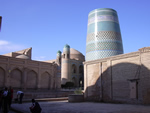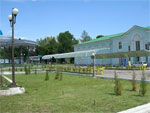|

http://www.advantour.com/uzbekistan/
Uzbekistan Travel Destinations
Uzbekistan has well preserved relics from the time when Central Asia was the centre of Tamerlane’s empire. Cities of today’s Uzbekistan, including Samarkand, Bukhara, Khiva, Tashkent and Shakhrisabz live in the imagination of the West as symbols of oriental beauty and mystery.
Many cities which are located on the territory of modern Uzbekistan, in ancient times were located on the Silk Road, on which caravans with goods traveled between the East and the West. The road got its name from silk - the Chinese good that was in great demand in Europe. The advantageous geographical location of the cities made them attractive for conquerors. The territory of modern Uzbekistan was conquered many times by various conquerors, including Alexander the Great. Alexander founded at least 8 cities in Central Asia between 334 - 323 years BC.
As for caravans, they started passing on the Great Silk Road later, since 138th AC when China opened its borders for trading.
During the period from 484 to 1150 the region was invaded by the west tribes: Huns, Turks and Arabs. The Arabs brought a new religion - Islam. Within that period, many mosques and madrasahs had been built in Samarkand, Bukhara and Khiva. Most of them had been built during the reign of Samanids.
Many cities were totally destroyed during the invasion of Genghis Khan in 1220. Later, the great conqueror Timur, known in the West under the name of Tamerlane, revived the destroyed cities using for that those slaves and builders who had been captured during Timir’s successful military campaigns. Tamerlane annexed Persia, Baghdad, he had campaigns to Anatolia and India. The majority of the architectural buildings that were located in Samarkand today, were built by Tamerlane and his grandson Ulugbek.
Uzbekistan Video
Cities of Uzbekistan
Samarkand, UZBEKISTAN
|
|
Samarkand is one of the oldest cities of Uzbekistan and of the world, in the middle of the first century BC it was known under the name of Marakanda and later known as Afrosiab. It was the capital of the powerful state Sogd, the center of Amir Timur's great empire. The numerous monuments of Samarkand and its suburbs impress tourists with their beauty and splendor. The refined architectural shapes, intricate ornamentation, mosaics, blue-tile domes and facades are interesting for all who visit theses beautiful buildings.
More on Samarkand, Uzbekistan
|

|
Bukhara, UZBEKISTAN
|
|
The settlement of Bukhara in Uzbekistan dates back to the 8th century and for next 200 years used to be the center of an expanding Islamic kingdom and prospered as a trade and intellectual center for Central Asia. During the Mongol invasion, It was destroyed by Genghis Khan in 1219. Subsequently it was ruled by a succession of regional powers, including descendants of Genghis Khan, Turks, and Uzbeks. Once one of Islam's most sacred cities, Bukhara contains many examples of fine Islamic architecture.
More on Bukhara, Uzbekistan
|

|
Khiva, UZBEKISTAN
|
|
Khiva is known as a museum city under the open sky. It existed as a town for about 900 years, but was developed into the settlement as it is seen today only by the 19th century, when it was the last oasis on the northern Russian slave trade rout. Important spiritual and cultural values came form the large scientific centers of astronomy, mathematics, and medicine that existed in this area centuries ago. One can wander through the narrow streets of Khiva, peeking into the small courtyards through the wooden carved doors. The life inside the gardens assures the visitor that it is not just a museum, but also a living city.
More on Khiva, Uzbekistan
|

|
Tashkent, UZBEKISTAN
|
|
Although Tashkent was probably first settled around the 1st century BC, written records date the city to its Arab occupation in the 8th century AD. The 13th-century defeat to Genghis Khan and his Mongolian forces threw Tashkent into an era of turmoil. The Mongols lost the city in the 14th century when the Timurids Empire seized control. The Timurids Empire ruled Tashkent until the late 15th century, when the Sheibanids swept through the region. Today, Tashkent is the capital of Uzbekistan.
More on Tashkent, Uzbekistan
|

|
Baysun, UZBEKISTAN
|
|
Do you wish to travel into time that will transfer you to a forbidden territory that keeps the memory of culture of Greek and Baktrian and Kushan kingdoms that fell into oblivion of heathen ceremonies of fire-worshippers, and shaman cults? Trade caravans traveled here through Iron Gates in narrow mountain canyon for thousands years. Armies of Alexander the Great, Chengiz Khan, Tamerlan passed through this area.
More on Baysun, Uzbekistan
|

|
Nukus, UZBEKISTAN
|
Nukus is located in the north of Uzbekistan near the Aral Sea, surrounded by three deserts - the Kara Kum, Kyzyl Kum desert and rocky - Ustyurt.
Despite the fact that the city is only 70 years, the land on which it stands, is an ancient cultural stratum, which archaeologists have identified as belonging to the IV century BC. er. - IV century AD.
More on Nukus and Muynak |
 |
Margilan, UZBEKISTAN
|
In 2007 Margilan celebrated its 2000 annversay Margilan lies in a picturesque place, before the former at the crossroads of trade caravans from China to the West and vice versa. It was the opening of the Silk Road linked the birth city of Margilan.
More on Margilan |
 |
Ferghana and the Ferghana Valley, UZBEKISTAN
|
The city of Fergana, in the south of the Ferghana Valley - is one of the youngest cities in Uzbekistan. It was founded in 1876, after joining the Kokand Khanate to the Russian Empire. And a new town called New Margilan was founded 12 km away from the city which became the center of Ferghana region.
More on Ferghana and the Ferghana Valley |
 |
Nurata, UZBEKISTAN
|
|
Even some local residents of Uzbekistan do not know well about the ancient history of the town. It was lost in the outskirts of Kyzyl Kum desert in the foothills of the mountains Nuratau (which stretch from Jizzakh to Navoi). The highest point of the whole mountain area is the peak Hayatbashi (2169 m).
In the meantime, this modest town - witness the millennial history.
More on Nurata
|

|
Namangan, UZBEKISTAN
|
|
The history of Namangan city dates back to XVII c, when a new settlement (Namankan) was founded for local salt miners in the north of Ferghana. In the XVII century here, following the devastating earthquake residents moved Aksikent (Ahsykenta) - the ancient city, who once was the center of the Fergana Valley. In the middle of the XVIII century the city became the administrative center of the provinces. In 1875 Namangan became the administrative part of Czarist Russia.
More on Namangan
|
 |
Kokand, UZBEKISTAN
|
Kokand city, located in the western part of the Ferghana Valley, one of the ancient cities of Uzbekistan. The first written evidence of the city Hukande, Havokande (old city) are found even in the annals of X century. The town was important trade center on the Silk Road and in the XIII century, like most Central Asian cities were destroyed by the Mongols
More on Kokand |

|
Sarmysh Say, Navoi, UZBEKISTAN
|
|
Sarmish-say is a river gorge on the south slope of the Karatau mountain ridge belonging to the Zarafshan mountain range. It is situated about 30 km northeast of the city of Navoi, which is about 170 km southwest of Samarkand.
More on Sarmish Say
|

|
Termez, UZBEKISTAN
|
|
Termez is located on the right bank of the Amudarya river and is one of the ancient cities of Central Asia. The city evolved throughout the history on different places around the modern city, reflecting multiple cultural layers depicted in remains of historical sites.
The cultural heritage that was developed from the inception of the city was completely destroyed by Genghis-Khan in 1220, after the city refused to surrender peacefully. A new city was erected to the east of the old town.
More on Termez
|

|
Uzbekistan Useful Links
- CIA - The World Factbook - Facts about Uzbekistan
- Uzbekistan - Information on Uzbekistan from the U.S. Department of State
- Republic of Uzbekistan Gov.Uz - State Authority’s Portal of the Republic of Uzbekistan
PUBLIC OFFER
|















